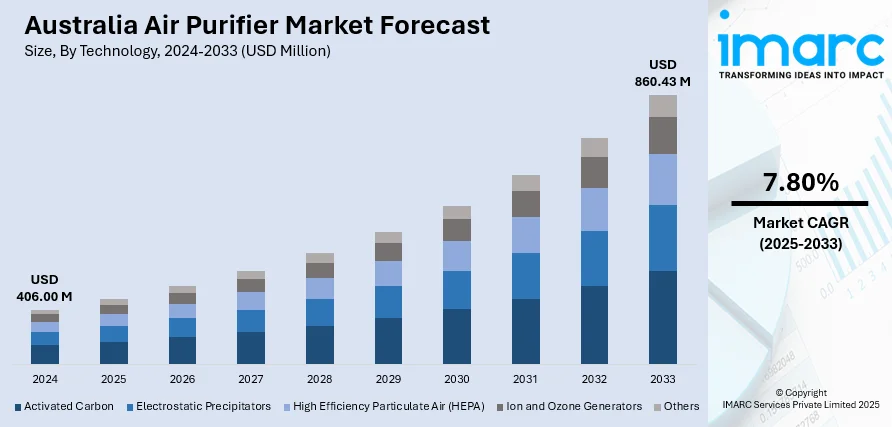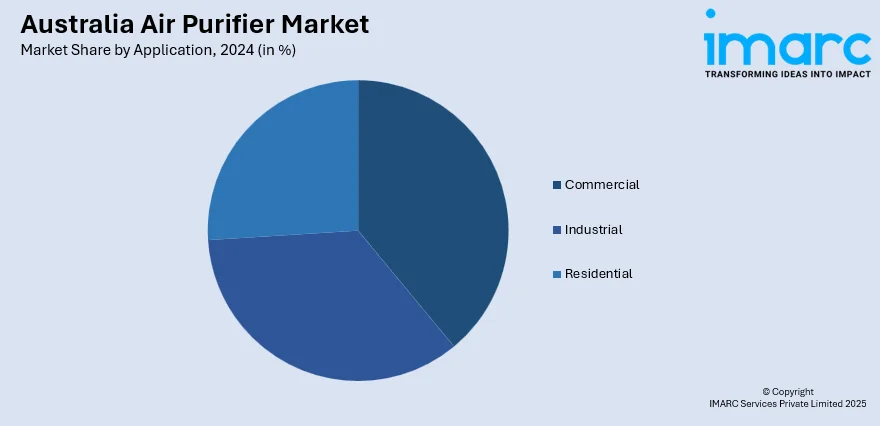
Australia Air Purifier Market Size, Share, Trends and Forecast by Technology, Size, Application, Distribution Channel, and Region, 2025-2033
Australia Air Purifier Market Size and Share:
The Australia air purifier market size reached USD 406.00 Million in 2024. Looking forward, IMARC Group expects the market to reach USD 860.43 Million by 2033, exhibiting a growth rate (CAGR) of 7.80% during 2025-2033. The market is witnessing steady growth due to rising concerns over indoor air quality, increasing urban pollution, and growing awareness about health hazards linked to airborne particles. Rising demand from households, commercial buildings, and healthcare facilities is driving product innovation, particularly in HEPA and activated carbon technologies. Smart and portable variants are also gaining popularity, thereby contributing positively to the Australia air purifier market share.
|
Report Attribute
|
Key Statistics
|
|---|---|
|
Base Year
|
2024 |
|
Forecast Years
|
2025-2033
|
|
Historical Years
|
2019-2024
|
| Market Size in 2024 | USD 406.00 Million |
| Market Forecast in 2033 | USD 860.43 Million |
| Market Growth Rate 2025-2033 | 7.80% |
Australia Air Purifier Market Trends:
Rising Health Consciousness
Rising health consciousness among Australian consumers is significantly influencing the air purifier market. With increasing reports of respiratory ailments such as asthma, bronchitis, and allergic rhinitis, particularly in urban centers like Sydney and Melbourne, more households are proactively seeking ways to improve indoor air quality. The AIHW's Australian Burden of Disease Study 2024 reveals asthma's burden has risen by 8.5% since 2003, now the 8th highest disease burden in Australia, affecting 5.3 per 1,000 population. It accounts for 11.9% of the total disease burden in children aged 5-14, emphasizing the need for improved management strategies. The situation is further exacerbated by recurring bushfire events and seasonal dust storms, which contribute to poor ambient air conditions. As people become more informed about the long-term health effects of pollutants, allergens, and fine particulate matter (PM2.5), there is growing preference for advanced air purifiers equipped with HEPA filters and real-time air quality sensors. Families with children, elderly individuals, or members suffering from pre-existing health conditions are especially inclined to invest in such products. This heightened health awareness is not only fueling market demand but also encouraging manufacturers to emphasize the health benefits of their offerings in marketing campaigns.

To get more information on this market, Request Sample
Rising Demand for Eco-Friendly and Energy-Efficient Models
Environmental awareness and energy conservation are playing a growing role in shaping consumer preferences in the Australia air purifier market. With rising electricity costs and a broader push toward sustainable living, buyers are increasingly opting for models that minimize power consumption and utilize eco-friendly materials. Energy-efficient purifiers with automatic sensors, sleep modes, and low-wattage motors are gaining traction, especially among urban dwellers and environmentally conscious households. Quiet operation is another major factor, as consumers seek devices that function effectively without disrupting daily activities or sleep. Manufacturers are responding by introducing products with improved energy ratings and recyclable components to align with evolving consumer expectations. This shift toward sustainability and efficiency is contributing to Australia air purifier market growth, as brands differentiate themselves through green innovations and align with national efforts to reduce carbon emissions.
Increased Demand in Commercial Spaces
Commercial demand is playing a key role in accelerating the growth of the Australia air purifier market. Following the COVID-19 pandemic, indoor air quality has become a top priority across public and private establishments. Offices are integrating air purifiers into HVAC systems to ensure a healthier workspace, improve employee well-being, and reduce sick days. Educational institutions, particularly schools and childcare centers, are adopting air purification technologies to limit airborne transmission of viruses and allergens among children. In the healthcare sector, hospitals and clinics are reinforcing infection control by deploying high-efficiency filtration units in patient areas, waiting rooms, and isolation wards. Regulatory guidelines and occupational safety protocols are further pushing organizations to invest in air quality solutions. This sustained demand from the commercial sector is contributing to stable market growth, encouraging continuous innovation and large-scale deployments.
Australia Air Purifier Market Segmentation:
IMARC Group provides an analysis of the key trends in each segment of the market, along with forecasts at the country and regional levels for 2025-2033. Our report has categorized the market based on technology, size, application, and distribution channel.
Technology Insights:
- Activated Carbon
- Electrostatic Precipitators
- High Efficiency Particulate Air (HEPA)
- Ion and Ozone Generators
- Others
The report has provided a detailed breakup and analysis of the market based on the technology. This includes activated carbon, electrostatic precipitators, high efficiency particulate air (HEPA), ion and ozone generators, and others.
Size Insights:
- Small Units
- Large Units
- HVAC Units
A detailed breakup and analysis of the market based on the size have also been provided in the report. This includes small units, large units, and HVAC units.
Application Insights:

- Commercial
- Industrial
- Residential
A detailed breakup and analysis of the market based on the application have also been provided in the report. This includes commercial, industrial, and residential.
Distribution Channel Insights:
- Offline
- Online
A detailed breakup and analysis of the market based on the distribution channel have also been provided in the report. This includes offline and online.
Regional Insights:
- Australia Capital Territory & New South Wales
- Victoria & Tasmania
- Queensland
- Northern Territory & Southern Australia
- Western Australia
The report has also provided a comprehensive analysis of all the major regional markets, which include Australia Capital Territory & New South Wales, Victoria & Tasmania, Queensland, Northern Territory & Southern Australia, and Western Australia.
Competitive Landscape:
The market research report has also provided a comprehensive analysis of the competitive landscape. Competitive analysis such as market structure, key player positioning, top winning strategies, competitive dashboard, and company evaluation quadrant has been covered in the report. Also, detailed profiles of all major companies have been provided.
Australia Air Purifier Market News:
- In June 2024, Coway announced the launch of the Airmega 100, an affordable cylindrical air purifier in Australia, designed for smaller spaces. Featuring 360° air intake and a 3-stage HEPA filtration system, it efficiently captures harmful pollutants.
- In March 2024, Acer announced the launch of its Acerpure home appliance range in Australia, featuring air purifiers, air circulators, and a cordless vacuum cleaner. Highlighted products include the Acerpure Pro UVC Air Purifier and the Cozy Pedestal Fan.
Australia Air Purifier Market Report Coverage:
| Report Features | Details |
|---|---|
| Base Year of the Analysis | 2024 |
| Historical Period | 2019-2024 |
| Forecast Period | 2025-2033 |
| Units | Million USD |
| Scope of the Report | Exploration of Historical Trends and Market Outlook, Industry Catalysts and Challenges, Segment-Wise Historical and Future Market Assessment:
|
| Technologies Covered | Activated Carbon, Electrostatic Precipitators, High Efficiency Particulate Air (HEPA), Ion and Ozone Generators, Others |
| Sizes Covered | Small Units, Large Units, HVAC Units |
| Applications Covered | Commercial, Industrial, Residential |
| Distribution Channels Covered | Offline, Online |
| Regions Covered | Australia Capital Territory & New South Wales, Victoria & Tasmania, Queensland, Northern Territory & Southern Australia, Western Australia |
| Customization Scope | 10% Free Customization |
| Post-Sale Analyst Support | 10-12 Weeks |
| Delivery Format | PDF and Excel through Email (We can also provide the editable version of the report in PPT/Word format on special request) |
Key Questions Answered in This Report:
- How has the Australia air purifier market performed so far and how will it perform in the coming years?
- What is the breakup of the Australia air purifier market on the basis of technology?
- What is the breakup of the Australia air purifier market on the basis of size?
- What is the breakup of the Australia air purifier market on the basis of application?
- What is the breakup of the Australia air purifier market on the basis of distribution channel?
- What is the breakup of the Australia air purifier market on the basis of region?
- What are the various stages in the value chain of the Australia air purifier market?
- What are the key driving factors and challenges in the Australia air purifier market?
- What is the structure of the Australia air purifier market and who are the key players?
- What is the degree of competition in the Australia air purifier market?
Key Benefits for Stakeholders:
- IMARC’s industry report offers a comprehensive quantitative analysis of various market segments, historical and current market trends, market forecasts, and dynamics of the Australia air purifier market from 2019-2033.
- The research report provides the latest information on the market drivers, challenges, and opportunities in the Australia air purifier market.
- Porter's five forces analysis assist stakeholders in assessing the impact of new entrants, competitive rivalry, supplier power, buyer power, and the threat of substitution. It helps stakeholders to analyze the level of competition within the Australia air purifier industry and its attractiveness.
- Competitive landscape allows stakeholders to understand their competitive environment and provides an insight into the current positions of key players in the market.
Need more help?
- Speak to our experienced analysts for insights on the current market scenarios.
- Include additional segments and countries to customize the report as per your requirement.
- Gain an unparalleled competitive advantage in your domain by understanding how to utilize the report and positively impacting your operations and revenue.
- For further assistance, please connect with our analysts.
 Request Customization
Request Customization
 Speak to an Analyst
Speak to an Analyst
 Request Brochure
Request Brochure
 Inquire Before Buying
Inquire Before Buying




.webp)




.webp)












